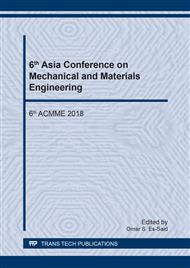[1]
T. Ling, J. G. Song, X.Y. Chen, J. Yang, Comparison of ZnO and TiO2 nanowires for photoanode of dye-sensitized solar cells, J. Alloy. Compd. 546 (2013) 307-313.
DOI: 10.1016/j.jallcom.2012.08.030
Google Scholar
[2]
J. G. Song, L. Hua, Q. Shen, Effect of pH value on the properties of SnO2 nano-cystalline for dye sensitized solar cells, Key Eng. Mater. 633 (2015) 273-276.
DOI: 10.4028/www.scientific.net/kem.633.273
Google Scholar
[3]
K. Fan, T.Y. Peng, J.N. Chen, A simple preparation method for quasi-solid-state flexible dye-sensitized solar cells by using sea urchin-like anatase TiO2 microspheres, J. Power Sources. 222 (2013) 38-44.
DOI: 10.1016/j.jpowsour.2012.08.054
Google Scholar
[4]
F. Yang, F. Zhang, E.Z. Wang, Research development of organic-inorganic perovskite solar cells, Powder Metal Indu. 26 (2016) 64-68.
Google Scholar
[5]
Y. Chen, H. Li, Q. Ma, Z.M. Zhang, J.P. Wang, G. Wang, A novel electrospun approach for highly-dispersed carambola-like SnO2/C composite microparticles with superior photocatalytic performance, Mater. Lett. 202 (2017)17-20.
DOI: 10.1016/j.matlet.2017.05.086
Google Scholar
[6]
T.T. Duong, H.J. Choi, Q.J. He, Enhancing the efficiency of dye sensitized solar cells with an SnO2 blocking layer grown by nanocluster deposition, J. Alloy. Compd. 561 (2013) 206-210.
DOI: 10.1016/j.jallcom.2013.01.188
Google Scholar
[7]
D.X. Cao, H.Y. Gu, C. Xie, B. Li, H.K Wang, Binding SnO2 nanoparticles onto carbon nanotubes with assistance of amorphous MoO3 towards enhanced lithium storage performance, J. Colloid Interf. Sci. 504 (2017) 230-237.
DOI: 10.1016/j.jcis.2017.05.056
Google Scholar
[8]
N. Liu, K. Lee, P. Schmuki, Small diameter TiO2 nanotubes vs. nanopores in dye sensitized solar cells, Electrochem Comm. 15 (2012) 1-4.
DOI: 10.1016/j.elecom.2011.11.003
Google Scholar
[9]
J. Wang, C. Wang, Y.Q. Kang, The effects of annealing treatment on microstructure and contact resistance properties of cold sprayed Ag-SnO2 coating, J. Alloy. Compd. 714 (2017) 698-703.
DOI: 10.1016/j.jallcom.2017.04.227
Google Scholar
[10]
G.M. Aponsu, T.R. Wijayarathna, I.K. Perera, The enhancement of photovoltaic parameters indye-sensitized solar cells of nano-crystalline SnO2 by incorporating with large SrTiO3 particles, Spectrochim Acta A. 109 (2013) 37-41.
DOI: 10.1016/j.saa.2013.02.016
Google Scholar
[11]
O. Almamoun, S.Y Ma, Effect of Mn doping on the structural, morphological and optical properties of SnO2 nanoparticles prepared by Sol-gel method, Mater. Lett. 199 (2017) 172-175.
DOI: 10.1016/j.matlet.2017.04.075
Google Scholar
[12]
W. Sun, X.H Sun, X.Z. Zhao, A low cost mesoporous carbon/SnO2/TiO2 nanocomposite counter electrode for dye-sensitized solar cells, J. Power Sources 201 (2012) 402-407.
DOI: 10.1016/j.jpowsour.2011.10.097
Google Scholar
[13]
P.N. Kumar, J.S. Mary, V. Chandrakala, W. J. Jeyarani, J. M. Shyla, Investigation of superior electro-optical properties of SnO2/SiO2 nanocomposite over its individual counterpart SnO2 nanoparticles, Mater. Chem. Phys. 193 (2017) 234-243.
DOI: 10.1016/j.matchemphys.2017.02.039
Google Scholar
[14]
J. Martikainen, A. Penttila, M. Gritsevich, H. Lindqvist, K. Muinonen, Spectral modeling of meteorites at UV-vis-NIR wavelengths, J. Quant. Spect. Rad. Trans. 204 (2018) 144-151.
DOI: 10.1016/j.jqsrt.2017.09.017
Google Scholar
[15]
N.H. Al-Hardan, M.A. Abdul Hamid, N.M. Ahmed, R. Shamsudin, N.K. Othman, Ag/ZnO/p-Si/Ag heterojunction and their optoelectronic characteristics under different UV wavelength illumination, Sens. Actu. A: Phys. 242 (2016) 50-57.
DOI: 10.1016/j.sna.2016.02.036
Google Scholar
[16]
K.X. Hu, P.H. Wang, L. Chen, Z.X. Zhao Q.K. Wang,Study on the photoelectric conversion efficiency of solar cells with light trapping arrays, Int. J. Light Elect. Opt. 135 (2017) 313-319.
DOI: 10.1016/j.ijleo.2017.01.084
Google Scholar
[17]
X.F. Fang, X.J Men, H.B. Chen Y.M. Zhang W.P. Qin, Fabrication and photoelectric properties of bio-inspired honeycomb film based on semiconducting polymer, J. Colloid. Interf. Sci. 512 (2018) 1-6.
DOI: 10.1016/j.jcis.2017.10.007
Google Scholar


